Samsung Portable SSD T1 Review
by Ganesh T S on January 20, 2015 10:00 AM ESTStorage Benchmarks
Synthetic Benchmarks - ATTO and Crystal DiskMark
Samsung claims read/write speeds of 450 MBps, and these are backed up by the ATTO benchmarks provided below. Unfortunately, these access traces are not very common in real-life scenarios.
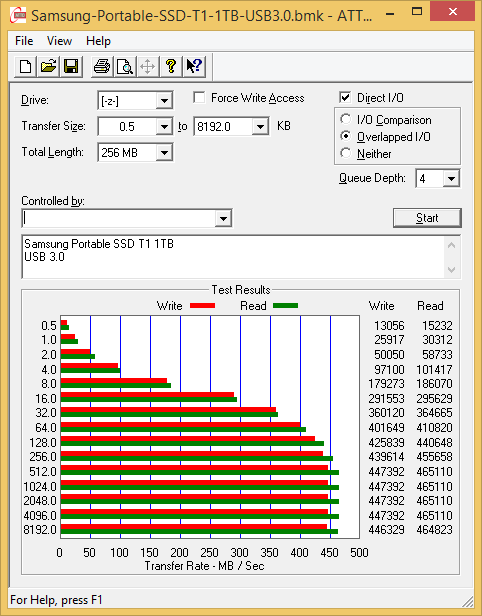
CrystalDiskMark, despite being a canned benchmark, provides a better estimate of the performance range with a selected set of numbers. As evident from the screenshot below, the performance can dip to as low as 26 MBps for 4K accesses at very low queue-depths. It can already be seen from the two benchmarks that enabling encryption doesn't alter the transfer rates at all.
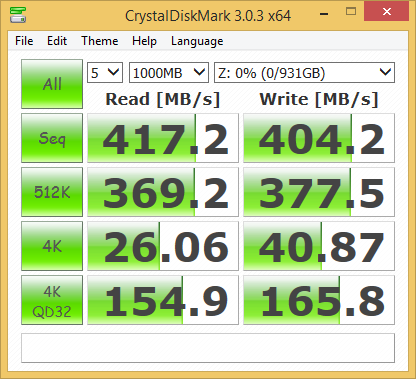
Benchmarks - robocopy and PCMark 8 Storage Bench
Our testing methodology for DAS units also takes into consideration the usual use-case for such devices. The most common usage scenario is transfer of large amounts of photos and videos to and from the unit. The minor usage scenario is importing files directly off the DAS into a multimedia editing program such as Adobe Photoshop.
In order to tackle the first use-case, we created three test folders with the following characteristics:
- Photos: 15.6 GB collection of 4320 photos (RAW as well as JPEGs) in 61 sub-folders
- Videos: 16.1 GB collection of 244 videos (MP4 as well as MOVs) in 6 sub-folders
- BR: 10.7 GB Blu-ray folder structure of the IDT Benchmark Blu-ray (the same that we use in our robocopy tests for NAS systems)





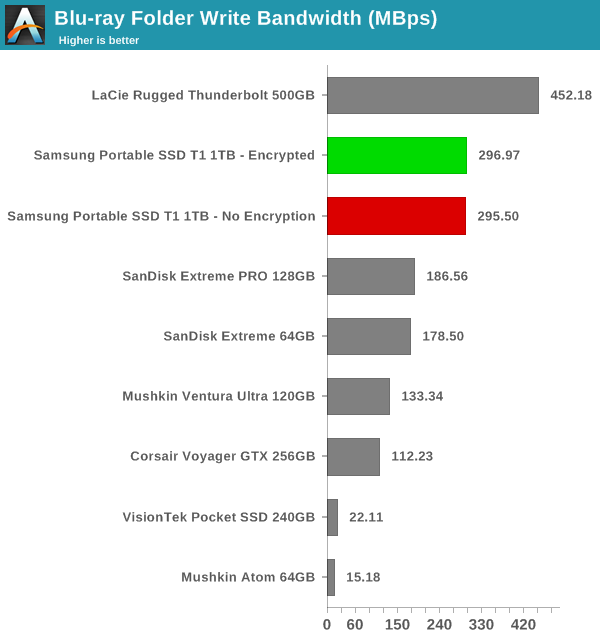
For the second use-case, we take advantage of PC Mark 8's storage bench. The storage workload involves games as well as multimedia editing applications. The command line version allows us to cherry-pick storage traces to run on a target drive. We chose the following traces.
- Adobe Photoshop (Light)
- Adobe Photoshop (Heavy)
- Adobe After Effects
- Adobe Illustrator
Usually, PC Mark 8 reports time to complete the trace, but the detailed log report has the read and write bandwidth figures which we present in our performance graphs. Note that the bandwidth number reported in the results don't involve idle time compression. Results might appear low, but that is part of the workload characteristic. Note that the same testbed is being used for all DAS units. Therefore, comparing the numbers for each trace should be possible across different DAS units.


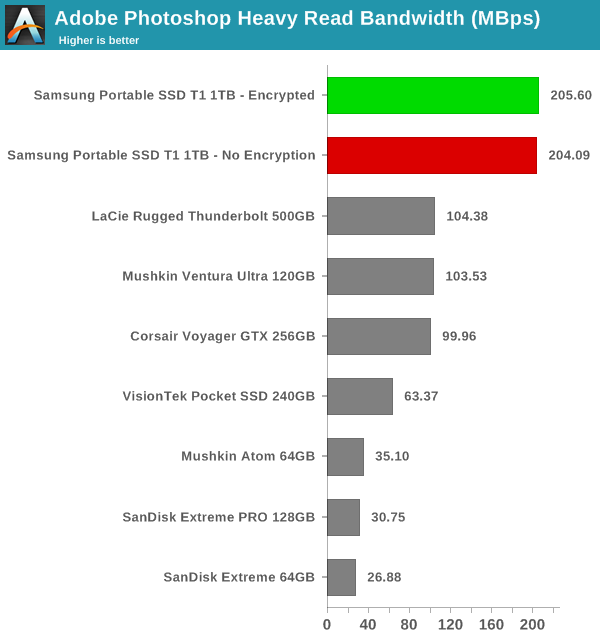

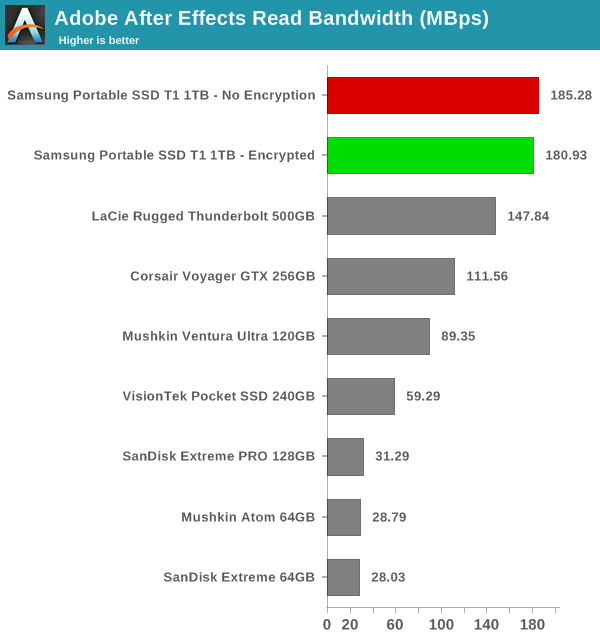
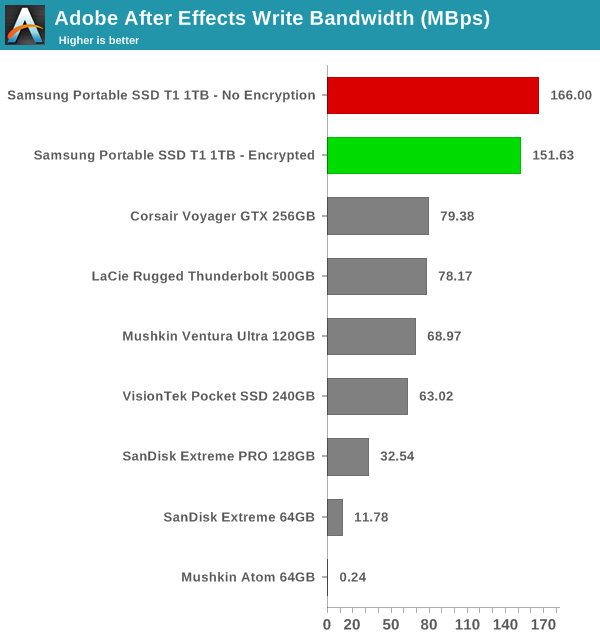
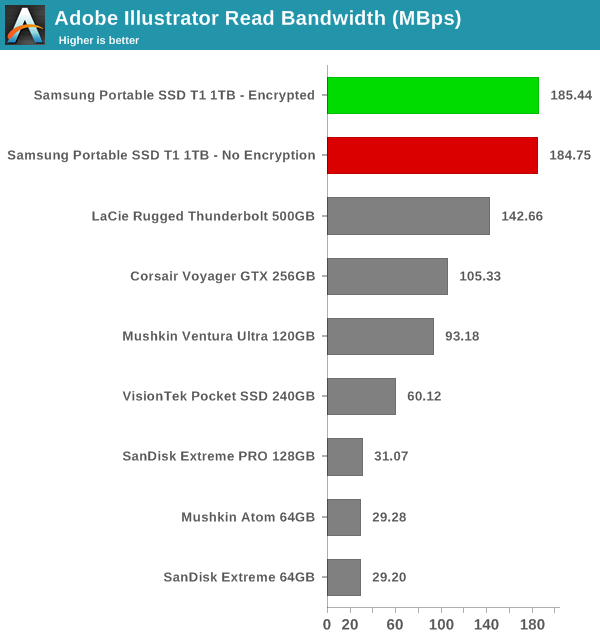

The 1TB Portable SSD T1 manages to win almost all the benchmarks, losing out on a couple of traces to the LaCie Rugged Thunderbolt 500GB version (which, incidentally, carries a Samsung PM851 behind a USB 3.0 - SATA bridge).










68 Comments
View All Comments
haukionkannel - Tuesday, January 20, 2015 - link
It would be very nice to see a comparison of external USB3 storage and different SSD disks to see if there is difference how well SSD will work without trim and is there is difference between controllers etc. It would be also nice to have an article for "dummies" how over provisioning affect in this kind of situation. I am also quite sure that not everyone knows how to change over provisioning with their SSD drives and how does it affect to ssd behavior.As it has been said you can get good quality USB3 enclosure and ssd for much less than there ready made versions. Comparison would be nice!
neillanz - Tuesday, January 20, 2015 - link
What I wonder about the most is if Samsung took care of unexpected power loss problem and if so, then how. The problem I always have while using an SSD with a SATA to USB bridge is that every time I disconnect it, the unexpected power loss count rises. Perhaps know with the UASP, it's possible to send a shutdown command to the drive itself.Laststop311 - Wednesday, January 21, 2015 - link
thats what the little icon in the tray is for. You right click it and select eject usb drive and then a bubble pops up and says it is now safe to disconnect your usb drive. You really didn't know that?neillanz - Wednesday, January 21, 2015 - link
Of course I know about the the Safe Removal option, but so far it never helped when unplugging an SSD. No matter what the unexpected power loss count would grow.digiguy - Tuesday, January 20, 2015 - link
I don't think this drive offers the same comfort of the GTX 256 or Sandisk extreme (I own both) on a very portable device, such as my Surface pro 3 or small ultrabooks. I wouldn't trust moving around with the device and this thing hanging. Also it would be interesting to know how much power this drive drains. According to my tests, the 2 pen drives I mentioned take very little power, while a 2.5" SSD in a USB 3.0 enclosure (I have several of both) takes much more power, much closer to a HDD. I have used a power meter, but even without that I can see that for instance with the Surface I can write between the 2 pen drives in an unpowered hub, and still have a mouse and something else attached, but I generally cannot do it between an external SSD and a pen (sometimes it works but the speed goes down), let alone 2 external SSDs. I have tested several unpowered hub, which themselves take some power, some more than others... Hopefully there will be some testing of the power consumption.Laststop311 - Wednesday, January 21, 2015 - link
You have to normalize the power consumption for the greater performance. Meaning since its faster it finishes the transfer faster and goes back into idle faster. So you need to take into account the amount of power used from transfer start to transfer finish. The other drives may use less power but they are transferring for a longer amount of time and that can easily bring its amount of battery power used close to equal.digiguy - Wednesday, January 21, 2015 - link
Normalize the power consumption for greater performance? I suppose you are comparing an external SSD with the pen drive I mentioned, as SSDs are actually much faster than HHD while consuming less.... As for pen vs SSD, considering the GTX, if we talk about read speed, they are pretty close.... I have several SSDs, among them Crucial MX100, Sandisk Extreme pro and the GTX is close and goes up to the limit of the USB 3.0 bandwith. In terms of write spead, there is a clear gap, but it's well known that write speed and the size of a pen drive don't go well together. Still, compared to "standard" USB 3.0 pen drives, these 2 I mentioned are amazing. The point I was making however was not about battery life, but about the capacity of a small laptop/ultrabook/convertible (as these drives are meant to be used mainly on the go) to power these drives, including moving data directly from one to the other. With the pen drives (even the fastest) you can do that, as their power consumption is a fraction of even that of an external SSD, let alone an HDD. So this is one of the strengths of such drives.sonicmerlin - Tuesday, January 20, 2015 - link
Augh I want someone to release a 20 nm V-NAND SSD that blows away the HDD market's $/GB values. When will this happen?Laststop311 - Wednesday, January 21, 2015 - link
Then you lose the benefits of 40nm which are numerous. Also while you can fit more nand dies per wafer with 20nm the process of making each wafer of dies is more expensive so if the increased amount of dies doesn't offset or better the increased cost of 20nm then it's actually cheaper for them to be at 40nm. You also have to take account of defect rates. If the defect rates of 20nm are a certain percentage higher than 40nm that also makes it hard for the increased amount of dies on 20nm to be enough of a bonus to make it cheaper.AJSB - Wednesday, January 21, 2015 - link
Please NO !20nm will bring back more problems than benefits, if i ever considered a SSD is precisely the 850 EVO because the type of NAND and be 40nm.
What happens now is that Samsung is charging a premium for be the only ones with this type of NAND, AFAIK.
When there will be more players doing it, prices will fall, not to mention that this type of NAND is still in the begin of production...as Samsung increases production, prices will possibly decrease with or without more OEMs doing this type of NAND.